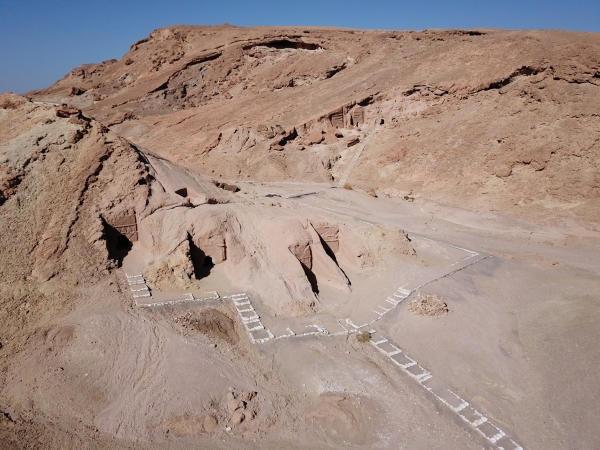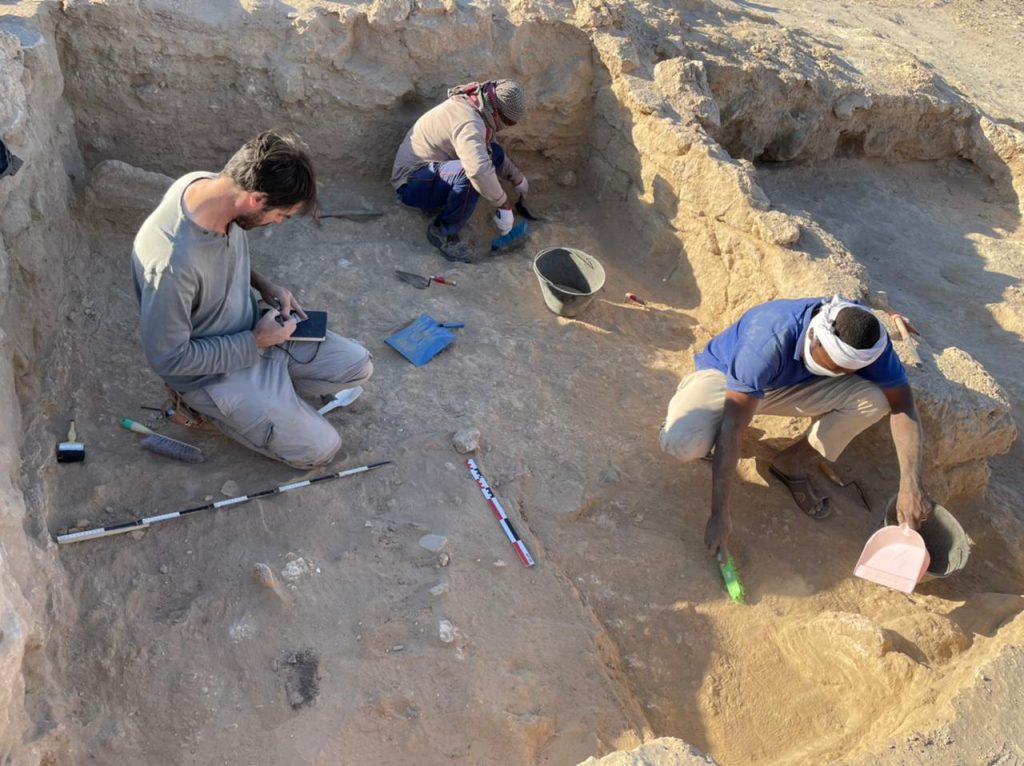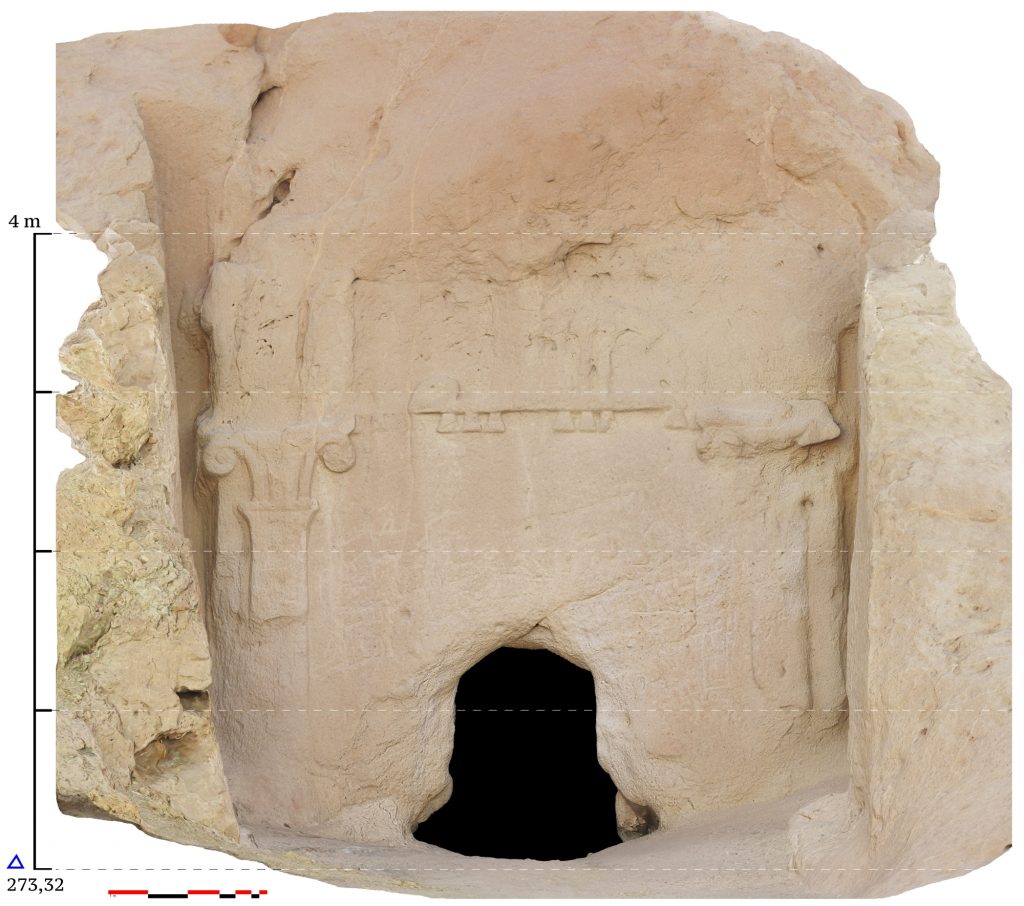al-Bad‘, l’ancienne Madyan (supposée Midian) (Arabie saoudite)
Située à l’est du Golfe de ʿAqaba dans une région sismique, l’oasis d’al-Badʿ occupe une zone d’environ 7 km de long sur environ 0,5 à 2 km de large. L’oasis a été visitée et mentionnée à plusieurs reprises par des géographes arabes durant la période médiévale, et par des voyageurs occidentaux après la « redécouverte » du site par Rüppel en 1829.

Tombes nabatéennes de Mughayr Shuʿayb à al-Badʿ, © BDAP, K. Guadagnini. The Nabataean tombs of Mughayr Shuʿayb at al-Badʿ, © BDAP, K. Guadagnini.
Les premières implantations humaines dans l’oasis
Les premières traces humaines dans la région remontent au Paléolithique. Dans les limites de l’oasis, les plus anciens indices d’occupation (semi-)permanente datent du Néolithique récent, soit la première moitié du VIIe millénaire av. J.-C. À cette époque, une petite communauté, cultivant des céréales, s’installe sur une terrasse de conglomérats sur le site d’Asifir. Après cette première installation, un long hiatus de trois millénaires reste inexpliqué et un petit village en pierre est fondé à la fin du IVe millénaire av. J.-C. sur le site de Rudayda, de l’autre côté du wadi ʿAfâl.

Fouilles d’une maison datant de la fin du IVe millénaire av. J.-C., à al-Badʿ, © BDAP, V. Blua. Excavation of a late fourth millennium BCE domestic dwelling in al-Badʿ, © BDAP, V. Blua.
Les occupations du premier millénaire av. J.-C.
Deux millénaires plus tard, au cours du premier millénaire av. J.-C., et possiblement dès la fin du deuxième millénaire av. J.-C., les recherches archéologiques montrent une forte densité d’occupation sur la rive orientale du wadi ʿAfâl sur une terrasse composée de gypse et de colluvions. Deux sites d’habitat (Rudayda Sud et al-Qala) et une nécropole (al-Qala Est) remontent à cette fourchette de temps très vaste et encore mal comprise.
Al-Badʿ et les Nabatéens
Avec Hégra et Dûmat, al-Badʿ constitue l’un des principaux sites nabatéens du nord-ouest de l’Arabie. La zone de Mughayr Shuʿayb, qui comprend des tombeaux sculptés dans le grès, fut décrite à plusieurs reprises par les voyageurs des XIXe et XXe siècles. Les données de terrain (céramique, monnaies et inscriptions) recueillies lors des prospections antérieures ont confirmé une occupation dense du milieu du Ier siècle av. J.-C. au IIe siècle, mais aussi jusqu’à la période byzantine au moins au IVe s.
Les recherches récentes permettent désormais de mieux définir l’organisation de l’espace oasien à l’époque nabatéo-romaine. Celle-ci comprenait une ville principale (al-Malha) d’environ 30 ha, entourée de nécropoles et de plusieurs petits hameaux dispersés. Les fouilles dans la ville ont, en particulier, dégagé un bâtiment domestique de forme presque carrée construit à cette période, et comportant 17 pièces dans sa phase byzantine supérieure. Une belle lampe en bronze avec des feuilles d’acanthe et deux dauphins datant de la période nabatéenne a été mise au jour dans une salle de bain privée au sein de cette bâtisse. La présence de bâtiments publics, d’un fort militaire, d’une probable citadelle (al-Qala) et de tombes monumentales taillées dans la roche, mais aussi la présence d’une culture matérielle abondante et raffinée, indiquent que l’oasis d’al-Badʿ accueillait des élites nabatéennes et fonctionnait comme un centre administratif et économique régional au tournant de l’ère chrétienne. L’identification de l’oasis avec la cité de Madiama/Madiana mentionnée par Flavius Josèphe et Ptolémée est vraisemblable.

Orthophotographie de la façade d’un tombeau nabatéen creusé dans la roche, à Mughayr Shuayb dans l’oasis d’al-Badʿ, © BDAP, L. Bigot & K. Guadagnini. Orthophotography of a Nabataean rock-cut tomb at Mughayr Shuayb © BDAP, L. Bigot & K. Guadagnini.
L’identification de Madian (ou Madyan)
Les sources écrites arabo-islamique permettent de faire le lien, de façon assurée, entre Madian (ou Madyan) et al-Badʿ. À ce stade des connaissances, deux sites (al-Malqata et al-Malha Nord) signalent une occupation sédentaire au début de l’ère islamique. Plus tard, et jusqu’à l’établissement des premiers villages en brique crue du XXe siècle, le seul site de l’oasis d’époque islamique médiévale connu semble avoir été le lieu de pèlerinage d’al-Burj, organisée autour du puits taillé dans la roche, le Biʾr Saʿidni, aussi appelé le « puits de Moïse ».
Al-Badʿ, Madian et Moïse
Alors que certains érudits envisagent de situer Madian dans le Sinaï ou au nord du Hijâz, il existe désormais un consensus scientifique selon lequel il s’agirait de l’oasis d’al-Badʿ dans la province de Tabuk. Madian (ou Madyan) – entité géopolitique du nord-ouest de l’Arabie à la fin du 2e millénaire avant J.-C. – jouit d’une grande importance chez les fidèles des trois religions du Livre. La Bible la mentionne quelque 60 fois – le plus souvent attachée à la figure de Moïse – le Coran y fait 10 fois référence. Deux des épisodes les plus significatifs mentionnés dans l’Ancien Testament sont l’accueil de Moïse par le prophète Jethro à Madian après sa fuite d’Égypte, puis l’offrande d’un sacrifice à Dieu sur le mont Sinaï, près de Madian, pendant l’Exode. Madian est ainsi liée aux origines d’Israël et aux nombreuses théories qui lui sont associées. A l’inverse, dans le Coran, le peuple de Madian est accusé d’idolâtrie et de pratiques commerciales malhonnêtes par Shuʿayb, un prophète envoyé par Dieu ; le peuple meurt ensuite sous l’effet de la colère de Dieu et d’un tremblement de terre divin.
Les perspectives de recherche
L’ampleur de la séquence chronologique et l’abondance du matériel archéologique confirment l’importance de l’oasis d’al-Badʿ, presque inconnue il y a seulement quelques années. L’étude de ce site livrera sans aucun doute des informations résolument novatrices pour la connaissance de l’histoire de la région dans les années à venir.
Partenaires scientifiques et soutiens financiers
En plus du soutien de la Commission saoudienne pour le tourisme et du patrimoine national (aujourd’hui la Commission du patrimoine du ministère de la culture), le projet bénéficie du soutien de l’Université du Roi Saoud et de nombreuses institutions françaises, en particulier le Centre national de la recherche scientifique recherche scientifique (CNRS), l’équipe Mondes sémitiques du laboratoire au laboratoire Orient & Méditerranée (UMR 8167), le Ministère français des Affaires Ministère français des Affaires étrangères et européennes, l’Ambassade de France à l’Ambassade de France à Riyad (SCAC), Hydroasis OPUS 2019 de l’Université de la Sorbonne l’Université de la Sorbonne, le Labex Resmed (ANR-10- LABX-72 / ANR-11-IDEX-0004-02) et le Centre français de recherche sur la péninsule arabique (Cefrepa).
English resume
Situated east of the Gulf of ʿAqaba in a seismic region, the oasis of al-Badʿ occupies an area about 7km long with variable widths between 0.5 km and 2 km. The oasis was visited and mentioned several times by Arab geographers during the medieval period, and by Western travellers following Rüppel’s visit in 1829.
The first human traces in the al-Badʿ region go back to the Palaeolithic period. Within the confines of the oasis, the oldest indications of (semi-)permanent occupation date to the Late Neolithic, the first half of the seventh millennium bce. At that time a small community, cultivating cereals, settled on a high terrace of conglomerates at the Asifir site. Following this first installation, there is a long gap of three millennia in the archaeological record that remains unresolved. Preliminary Investigations suggest the existence of a small village of stone dwellings from the end of the fourth millennium bce on the site of Rudayda, on the other side of Wadi ʿAfal.
Much later, during the first millennium bce, recent archaeological investigations now emphasise a high density of occupation at the oasis – the oldest of which probably falls at the end of the second millennium bce (previously known as ‘Madianite period’). The occupation at this time appears to be concentrated on the eastern shore of Wadi ʿAfal on a gypsum and colluvial terrace. Two settlement sites (Rudayda South and al-Qala) and a necropolis (al-Qala East) date back to this vast chronological range.
Along with Hegra and Dumat, al-Badʿ is considered to have been one of the main Nabataean sites in north-western Arabia. The area of Mughayr Shuʿayb, which contains ostentatious rock-cut tombs, is the most well documented by previous travellers and explorers. Field data (pottery, coins and inscriptions) collected during previous surveys confirmed a dense occupation from the middle of the first century bce to the second century ce, but also until the Byzantine period. Recent observations enable us to understand more clearly the organisation of the Nabataean-Roman occupation at the oasis, which comprised a main city (al-Malha) of approximately 26ha, surrounded by necropoleis and a series of small dispersed hamlets. The excavations in the city revealed in particular an almost square domestic building featuring 17 rooms in its upper Byzantine phase. It also yielded a nice bronze lamp with acanthus leaves and two dolphins in a private bathroom dating to the Nabataean period. The presence of public buildings, a military fort, a probable citadel (al-Qala) and monumental rock-cut tombs, but also the presence of refined and abundant material culture, indicate that the oasis of al-Badʿ hosted local elites and functioned as the seat for regional administration during the Nabataean and Roman periods.
The identification of Madyan with al-Badʿ comes from Arab-Islamic textual sources and is certain. Two sites (al-Malqata and al-Malha North) currently indicate sedentary occupation at the oasis of al-Badʿ during the Early Islamic period. Later, and until the establishment of the first mud-brick villages of the twentieth century, the only site at the oasis seems to have been the pilgrimage station of al-Burj, organised around the rock-cut well Biʾr Saʿidni, the so-called “Moses well”.
The magnitude of the chronological sequence and the abundance of archaeological material confirm the major importance of the al-Bad’ oasis, almost unknown only 5 years ago. The study of this major site will undoubtedly deliver resolutely innovative information for the knowledge of the history of the region in the years to come.
In addition to the support from the Heritage Commission of the Ministry of Culture, the project benefits from the support of the King Saud University and many French institutions, in particular the French National Center for Scientific Research (CNRS), the Mondes sémitiques team at the laboratory Orient & Méditerranée (UMR 8167), the French Ministry of European and Foreign Affairs, the French Embassy in Riyadh, Hydroasis OPUS 2019 from Sorbonne University, the Labex Resmed (ANR-10- LABX-72 / ANR-11-IDEX-0004-02) and the French Centre for research on the Arabian Peninsula (Cefrepa).
Articles
CHARLOUX G., Sahlah S.A. & Badaiwi W.A., 2021, « Madian revealed ? Assessing the history and archaeology of the oasis of al-Badʿ in north-western Arabia », Semitica & Classica 14, p. 97-142. https://doi.org/10.1484/J.SEC.5.129522
CHARLOUX G., Sahlah S.A., Badaiwi W.A., with the participation of Almadhi S.M., Al Timani A.E.K., Al Nawfal A.A., Al Qahtani M.A., Guadagnini K. & Larché F., 2021 (accepté, sous presse), « The Archaeological Project in Al-Bad‘ (Tabuk Province) _ 2017 Season », Atlal.
CHARLOUX G., Sahlah S.A., Badaiwi W.A., with the participation of Abady Mahmoud M.A., Almadhi S.M., Bernard P., Bigot L, Cosandey C., Crassard R., al-Shaya O.D., Darles C., Desruelles S., Dinies M., Guadagnini K., Guetta K., ElNasseh A., Gavazzi B., Laroye J., Al Timani A.E.K., Mensan R., al-Mutairi M.M. & Naggiar L., 2021 (accepté, sous presse), « The Archaeological Project in Al-Bad‘ (Tabuk Province) _ 2018 Season », Atlal.
CHARLOUX G., Sahlah S.A., Badaiwi W.A., with the participation of al-’Ajmi K.b.B., al-Uneizi T.b.A., Bernard P., Bigot L., Cabaret D.-M., Chung-to G., Cosandey C., Crassard R., Durand B., Guadagnini K., Hilbert Y., al-Taimani A.b.K., al-Khibri F.b.M., Gavazzi B., Laroye J, Al Timani A.E.K., Marchand S., Mazurek S., Naggiar L. & Vobauré M., 2021 (accepté, sous presse), « The Archaeological Project in Al-Bad‘ (Tabuk Province) _ 2019 Season », Atlal.




